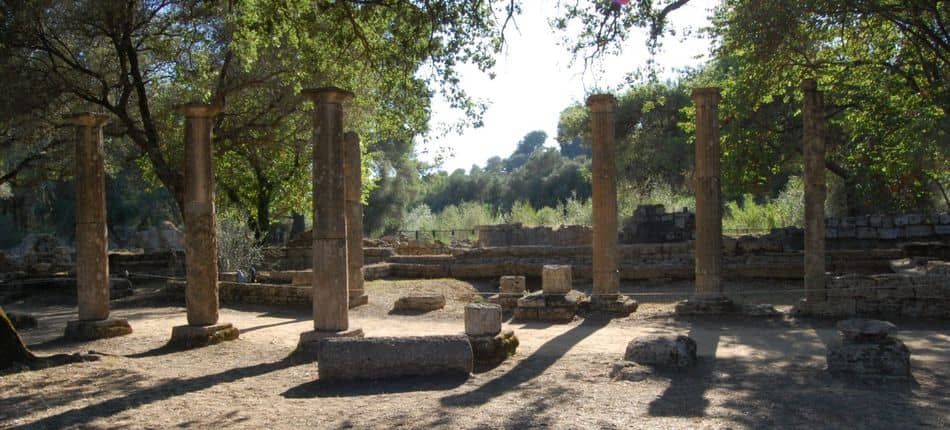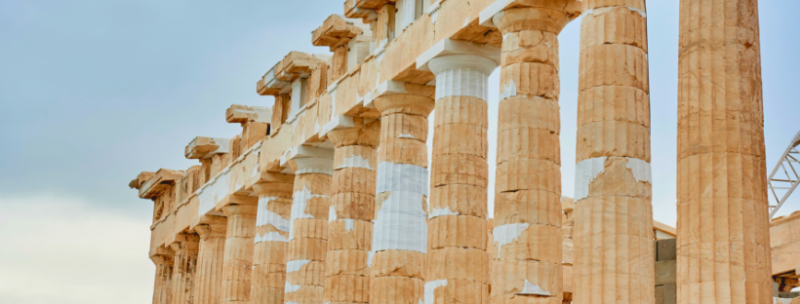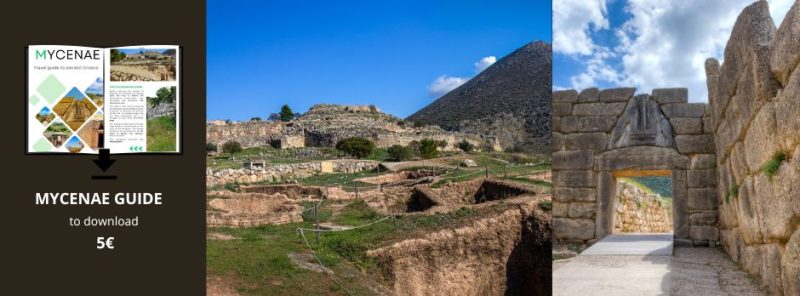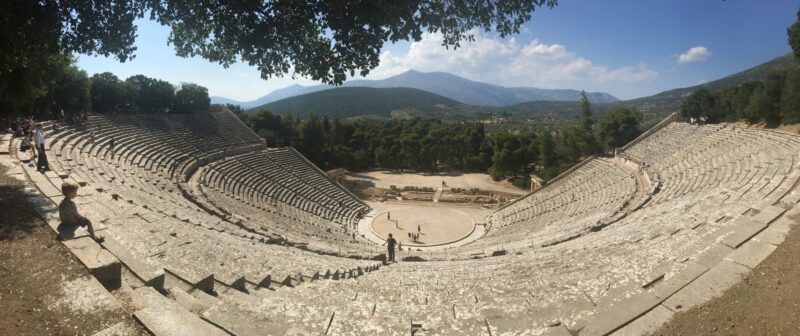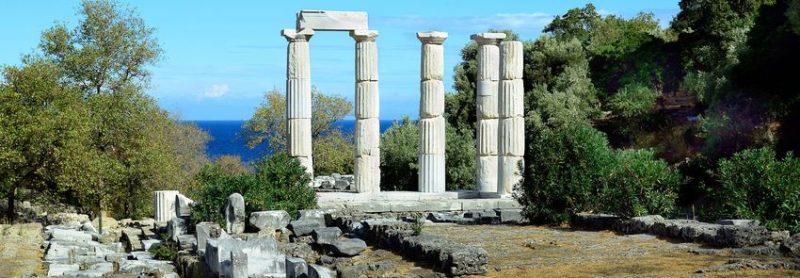Olympia is one of Greece’s most important and best-known archaeological sites. Firstly, because it’s the birthplace of the famous Olympic Games, the now worldwide sporting competition. Every 4 years, at a ceremony in Olympia, the Olympic flame is lit before it leaves for the host country. And in ancient times, Olympia was also an important place of worship, with its temple to Zeus. The archaeological site is one of 20 in Greece to be classified as a Unesco World Heritage Site. The sanctuary of Olympia has ensured unity and peace in the Hellenic world for centuries, and is now a must-see in Greece.
Where is Olympia?
Olympia is located in the north-western Peloponnese, 300km from Athens. Today’s Olympia has gradually developed into a major tourist center. Google Maps point
Access to the archaeological site is via a road lined with laurel, cypress and olive trees. As you approach the site, you cross the bridge over the River Kladéos, which flows to the west of ancient Olympia and joins a little further on the course of the Alpheus, a river often sung by poets, which marks the southeastern border of the sanctuary. The site nestles between the two rivers and the Cronion hill.
Practical information for visiting the Olympia site
Olympia site opening times
The site is open daily from 8:30 to 15:30 in low season (November to March) and from 8:00 to 20:00 in high season (April-October).
Closed on the following public holidays: January 1, March 25, May 1, Easter Sunday, December 25 and 26.
Schedules are subject to change, so check the official website before your visit.
Olympia site rates
- Full price €20
- Reduced rate €10 (for European citizens over 65 between October 1st to May 31)
- Free admission for Europeans under 25, non Europeans under 18, and also disabled persons and accompanying adults.
Access to the Olympia site is also free on March 6, April 18, May 18, the last weekend in September, October 28, and the first and third Sunday of November to March inclusive.
You can buy your full-price ticket online:
- On Civitatis: Olympia Archaelogical site tickets
- On Get Your Guide: Entrance ticket to the archaeological site and 2 museums, invluded Archaeological Museum and Museum of the History of the Olympic Games
- or Hellenic Heritage (in English), also for reduced and free tickets.
Visit Olympia on your own or with a guide?
Visit Olympia on your own
You can explore the site on your own. Nevertheless, you’ll find it hard to understand the ruins without guidance. A visit to the museum can help you better understand the history of the sanctuary. You can also continue reading this same article, which gives a few pointers.
- We also spotted this Tour of Olympia with virtual reality goggles, in English. We haven’t tested it, but the reviews are very good. A great way to see temples and monuments as they were in ancient times. Ticket not included
- And for audioguide fans, this entry ticket to the Olympia archaeological site + audioguide in English. Also untested.
Visit Olympia with an official guide
Only official guides are authorized to accompany tourists on the site. It’s a big budget, but an exciting one. Rates are per group, so at least four people are recommended. Here are a few possibilities:
- This private guided tour in English on GetYourGuide with very good reviews.
- For those arriving by boat from the port of Katakolo, you can book a transfer from the port to the site of Olympia.
A few historical landmarks…

Olympia is one of these mythical Greek sites. In fact, it was a sanctuary dedicated to Zeus.
Olympia was inhabited as early as 3000 B.C. Mycenaean settlements dating from 1400 B.C. have been found, along with rich tombs. But the Mycenaean palaces were destroyed and the sanctuary dedicated to new deities.
By the 9th century BC, Olympia was already a popular sanctuary, followed by the construction of the Temple of Hera. But it was not until the 5th century BC that Olympia really began to prosper, with the construction of the Temple of Zeus and other buildings in the sacred Altis.
During the Roman period, the site remained central to the holding of the Olympic Games in the Roman Empire. The site is enriched by new temples.
But in 393 AD, the last Olympic Games were held. The games were abolished by Theodosius the Great in 395 AD, and Olympia was deserted. The Temple of Zeus burned down a few years later.
It wasn’t until the 19th century that excavations began, first by a team of French archaeologists, then by a German team.
The Olympic Games
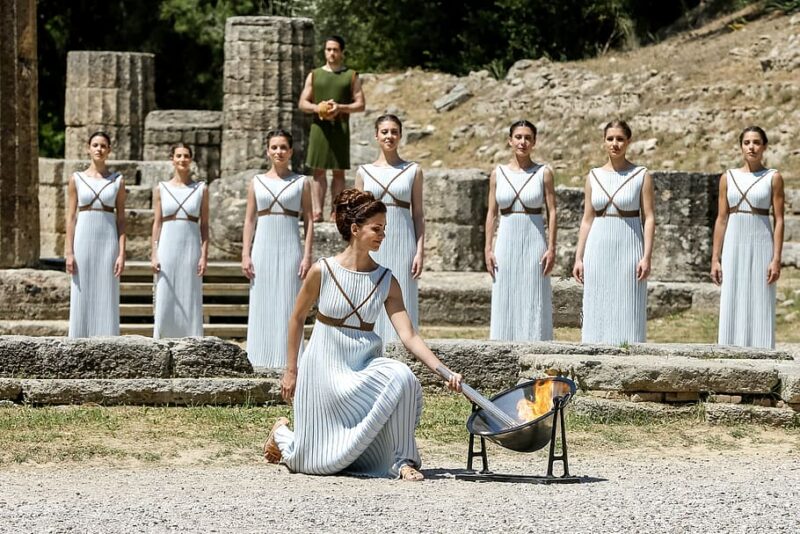
The Olympic Games began as early as 776 B.C. and survived until the 4th century A.D., a tradition that spanned the years, beliefs and empires.
They lasted a month and brought together athletes from far and wide. Games were divided into two main categories: gymnastic games and equestrian games.
In the 19th century, under the influence of Pierre de Coubertin, this tradition was revived, and the modern Olympic Games were held for the first time in Athens in 1896, in the marble stadium that can still be visited today.
Since 1936, the Olympic flame has been collected from the ancient site of Olympia and transported to the host country.
A fine tradition that continues to this day…
The main monuments on the archaeological site
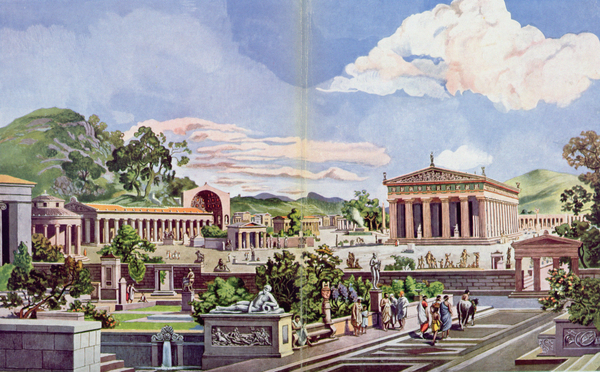
Entrance to the sanctuary was from the northwest. To the right of the Altis stretched a series of buildings for athletes and visitors.
The Altis
A wall delimits Altis to the south and west. This was the heart of the sanctuary. Here are some of the monuments not to be missed at this location:
- The temple of Hera is one of the best preserved on the site, yet also one of the oldest. It is in front of this temple that the Olympic flame is lit.
- The Temple of Zeus: majestic, it measured 64 metres long and 24 metres wide. It housed a huge chryselephantine statue in gold and ivory of Zeus on his throne. It was built by the sculptor Phidias, whose workshops can be found on the site.
- The philippeion: built by Philip II of Macedonia, this pretty round temple housed statues of the family.
- Pelopion: monument to Pelops
Sports facilities
- Stadium: the track is still clearly visible, as is the marble starting line on the ground.
- Gymnasium: the location of the former indoor gymnasium is still clearly visible.
- Leonidaion: a huge square building at the entrance to the sanctuary, housing multiple rooms around a garden. It welcomed athletes and distinguished guests.
The museums
There are two museums to visit in Olympia: the Archaeological Museum and the Olympic Games Museum.
Olympia Archaeological Museum
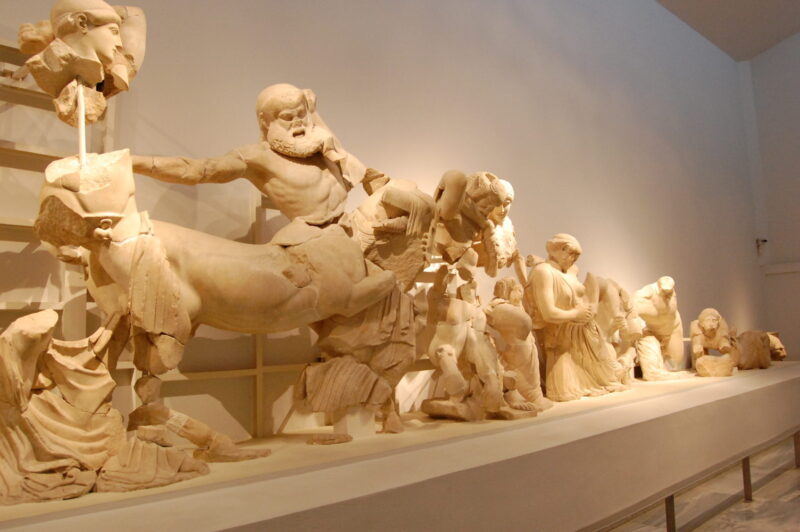
The rooms of the new Olympia Museum, built opposite the archaeological site, display the finds made in the region in chronological order.
There are some very fine pieces: artifacts from the Neolithic and Mycenaean to the Archaic periods. You can also admire the sculptures of the Temple of Zeus. The Museum’s most important work is undoubtedly the statue ofHermes. Depicted standing naked, he holds little Dionysus on his right arm.
Another remarkable statue of classical Greek art is the Victory of Paionios. Consecrated by the Messenians and Naupactians, it marks their victory over the Spartans in 425 BC, during the Peloponnesian War.
The Olympic Games Museum
This museum exhibits objects relating to the modern Olympic Games, as well as a collection of stamps, the only one of its kind in the world, with the Olympic Games as their theme.
Practical information about getting to and staying in Olympia
How to get to Olympia
- By car: Olympia is just a 3-hour drive from Athens on the freeway that runs along the Gulf of Corinth. You can easily rent a car, as we explain in this article: All our tips for renting a car in Greece.
- By bus: You can get to Olympia by KTEL bus. It’s a bit complicated because there are no direct buses.
- Sightseeing buses: some agencies offer a round trip to Olympia and back in the same day. It’s really short, but doable. Choose three-day or four-day packages that combine several sites in the Peloponnese(Mycenae, Epidaurus, Olympia and Meteora). These are generally quite economical packages in English.
- By boat: Olympia is often a favorite site for cruisers stopping off at Katakolon. Transfers from the port to the site are available.
Where to stay in Olympia?
- In Olympia: the site lacks a little charm because it’s so touristy, but there’s plenty of accommodation available. One of our readers highly recommends the Hotel Europa (see comment below).
- In the mountains: the mountains of the central Peloponnese are sublime. Access is a little longer, but we loved staying at Dimitsana and Ampeliona in the following hotels: Proselinos (in the heart of the village of Dimitsana) and Abeliona Retreat (a cosy place in a beautiful chestnut grove).
- By the sea: the coast near Olympia boasts long white sandy beaches. The hotels are generally not very charming, but access to the sea is easy. Around Kaiafas, for example. And if you want to treat yourself, you can visit the Dexamenes Seaside Hotel, a luxury seaside hotel housed in a successful industrial-style former wine warehouse. Last but not least, families tend to love the Grecotel La Riviera & AquaPark.
Written by Sophie B. in collaboration with archaeologist Mania F.
Contact: Tel +30 26240 22517 / Mail: efahle@culture.gr / Official website
